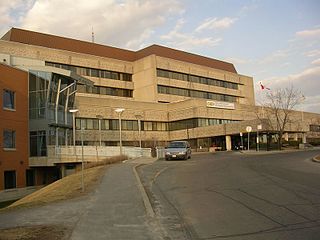
CHEO is a pediatric health-care and research centre located in Ottawa, Ontario, Canada. CHEO is also a tertiary trauma centre for children in Eastern Ontario, Nunavut, Northern Ontario and the Outaouais region of Quebec and one of only seven Level I trauma centres for children in Canada. It is affiliated with The Ottawa Hospital and the University of Ottawa, and is funded by the provincial Government of Ontario. CHEO first opened its doors on May 17, 1974, and is located at 401 Smyth Road, Ottawa, Ontario.

Monash Medical Centre (MMC) is a teaching hospital in Melbourne, Australia. It provides specialist tertiary-level healthcare to the Melbourne's south-east.

Queen Elizabeth Hospital, QE or QEH in short, is one of the largest acute general hospitals in Hong Kong. It was named after Queen Elizabeth II. The hospital is a major tertiary hospital in southern Kowloon, with over 1,900 beds. It employs more than 500 physicians and surgeons.

Vancouver Hospital and Health Sciences Centre (VHHSC) is an acute care hospital affiliated with the University of British Columbia and located in Vancouver, British Columbia. The VHHSC is the second largest hospital in Canada, with 1,900 beds and nearly 116,000 patients each year. VHHSC employs 9500 staff and utilizes 1000 volunteers. As of 2005, the hospital's annual budget is $463 million. It is managed by Vancouver Coastal Health.
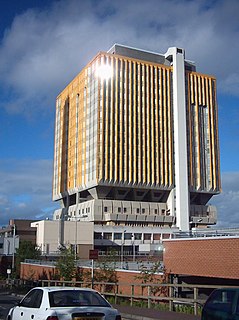
The Belfast City Hospital in Belfast, Northern Ireland, is a 900-bed modern university teaching hospital providing local acute services and key regional specialities. Its distinctive orange tower block dominates the Belfast skyline being the third tallest storeyed building in Ireland. It has a focus on the development of regional cancer and renal services. It is managed by Belfast Health and Social Care Trust and is the largest general hospital in the United Kingdom. In April 2020, due to the global coronavirus pandemic, the tower block was designated one of the UK's Nightingale Hospitals.
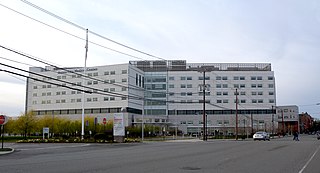
The Jersey City Medical Center is a hospital in Jersey City, New Jersey. The hospital has had different facilities in the city. It is currently located on a 15-acre campus at Grand Street and Jersey Avenue overlooking New York Harbor and Liberty State Park. The campus includes three facilities: the Wilzig Hospital, the Provident Bank Ambulatory Center, and the Christie Kerr Women's Health Center. The hospital serves as a regional referral and teaching hospital.

Musgrave Park Hospital is a specialist hospital in Belfast, Northern Ireland. It specialises in orthopaedics, rheumatology, sports medicine and rehabilitation of patients of all ages. These specialties are spread out across a large site in the leafy suburbs of South Belfast. The Hospital is named after the 48 acres (19 ha) of adjacent municipal parkland known as Musgrave Park, first opened to the public in 1920. The hospital is managed by the Belfast Health and Social Care Trust.

Nepean Hospital is a 520-bed teaching hospital and regional trauma centre, providing tertiary referral services for the Nepean Blue Mountains Local Health District. Nepean Hospital is located at the base of the Blue Mountains in Kingswood, New South Wales, Australia.

Middlemore Hospital is a major public hospital in the suburb of Otahuhu, Auckland, New Zealand. The hospital has approximately 800 beds. There are 24 operating theatres across two sites.
St. Cloud Hospital is a hospital in St. Cloud, Minnesota, United States. It is a Catholic-affiliated, not-for-profit institution and part of the CentraCare Health System. The hospital has more than 9,000 employees, 400 physicians and 1,200 volunteers. It serves 690,000 people in a 12-county area.

The Royal Alexandra Hospital (RAH) is a large and long serving hospital in the Canadian province of Alberta. Operated by Alberta Health Services and located north of Edmonton's downtown core, the Royal Alexandra serves a diverse community stretching from Downtown Edmonton to western and northern Canada. The total catchment area for the RAH is equivalent to 1/3 of Canada's land mass, stretching north from Downtown Edmonton to enpass both the Northwest Territories and Yukon territory, and stretching as far west as British Columbia's pacific coast.
Carroll Hospital is a nonprofit hospital located in Westminster, Maryland, United States.
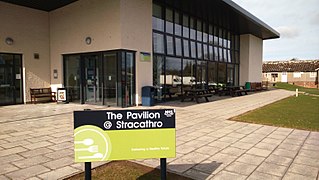
Stracathro Hospital is a community hospital in Angus, Scotland. Established as a wartime Emergency Hospital Service facility, it became a District General Hospital. Since 2005 it has been the site of the Scottish Regional Treatment Centre.

Royal Columbian Hospital (RCH) is the oldest hospital in British Columbia and one of the busiest in the Fraser Health Authority. It is located in New Westminster overlooking the Fraser River and is the only hospital in the Lower Mainland that is immediately adjacent to a Skytrain station (Sapperton).
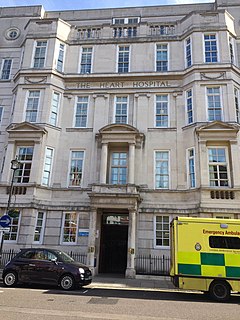
University College Hospital at Westmoreland Street, named The Heart Hospital until refurbished and renamed in 2015, was a specialist cardiac hospital located in London, United Kingdom until 2015. It is part of the University College London Hospitals NHS Foundation Trust and is closely associated with University College London (UCL). After the 2015 refurbishment the hospital now provides thoracic surgery, and urology services.

Kingsley Green is a mental health and learning disability site located in Hertfordshire, England, just southeast of the village of London Colney.

Andover War Memorial Hospital is a community hospital in Andover, Hampshire. The hospital provides inpatient rehabilitation, day hospital services, a minor injury unit and an outpatient unit. It is operated by Hampshire Hospitals NHS Foundation Trust, but some services are provided by Southern Health NHS Foundation Trust. The Countess of Brecknock Hospice is located on the same site as the hospital. The independent regulator of health and social care in England, the Care Quality Commission, rated Andover as "requires improvement" overall in 2018.

Whiteabbey Hospital is a hospital located close to the village of Whiteabbey, within the town of Newtownabbey, Northern Ireland. The hospital first opened in 1907 as The Abbey Sanitorium, centred around a country house known as 'The Abbey'. The house has stood on the site from 1850, and was once the residence of prominent architect Charles Lanyon. The hospital was extended and several buildings added throughout the early 20th century, and it was renamed Whiteabbey Hospital in 1947. The hospital is managed by the Northern Health and Social Care Trust. Many healthcare services have been withdrawn from the hospital, most recently with the closure of the Minor Injuries Unit in 2014.

Holywell Hospital is a facility that provides a range of mental health services in the Northern Health and Social Care Trust. Based on a 140-acre site in Antrim, the 149-bed facility is managed by the Northern Health and Social Care Trust.
Forster Green was the founder of Forster Green and Company, a leading firm of tea and coffee merchants in Northern Ireland and the benefactor of Forster Green Hospital, a non-acute hospital in South Belfast, Northern Ireland.



















